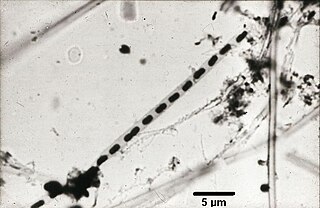
The Comamonadaceae are a family of the Betaproteobacteria. Like all Pseudomonadota, they are Gram-negative. They are aerobic and most of the species are motile via flagella. The cells are curved rod-shaped.

The Methylobacteriaceae are a family of Hyphomicrobiales.

The Oceanospirillales are an order of Pseudomonadota with ten families.
Oceanospirillaceae is a family of Pseudomonadota. Most genera in this family live in environments with high concentrations of salt; they are halotolerant or halophilic. They are marine, except Balneatrix which is found in fresh water and Venatorbacter, which is from terrestrial origin.All members are strictly aerobic, except Neptunomonas which can perform fermentation reactions.
Slackia is a genus of Actinomycetota, in the family Coriobacteriaceae. Slackia is named after the microbiologist Geoffrey Slack.

Bacteroidales is an order of bacteria. Notably it includes the genera Prevotella and Bacteroides, which are commonly found in the human gut microbiota.

The Bacteroidaceae are a family of environmental gram-negative bacteria commonly found in the human gut microbiota.
The Oceanimonas are a genus of marine bacteria. They are, like all Proteobacteria, gram-negative. The rod-shaped, motile organisms are aerobic and chemoorganotroph.
Hyphomonadaceae are a family of bacteria in the order Caulobacterales.
Tolumonas is a genus of Gram-negative bacteria. It grows under aerobic and anaerobic conditions and is nonmotile. The cells are rods and occur in pairs or singly. It is known for one of its species biological bacterial production of toluene from phenylalanine and other phenyl precursors
Brucella endophytica is a Gram-negative, aerobic, rod-shaped and bacteria from the genus of Brucella which has been isolated from the roots of the plant Glycyrrhiza uralensis from Yuli County in China.
Caldanaerobacter is a Gram-positive or negative and strictly anaerobic genus of bacteria from the family of Thermoanaerobacteraceae.
Carboxydothermus is a genus of thermophilic, anaerobic bacteria from the family of Thermoanaerobacteraceae.
Gaiella occulta is a rod-shaped and non-motile bacterium from the genus Gaiella which has been isolated from deep mineral water in Portugal.
The Dermatophilaceae is a Gram-positive family of bacteria placed within the order of Actinomycetales. Dermatophilaceae bacteria occur on animal and human skin and in fish guts.
Phycisphaeraceae is a family of bacteria.
Ectothiorhodosinus is a genus of bacteria from the family of Ectothiorhodospiraceae with one known species. Ectothiorhodosinus mongolicus has been isolated the Lake Dzun-Uldziit-Nur in the Mongolia.
Thiorhodospira is a genus of bacteria from the family of Ectothiorhodospiraceae with one known species.
Weeksellaceae is a family in the order Flavobacteriales.
The Opitutaceae are a Gram-negative and chemoheterotrophic order of the domain Bacteria. Opitutaceae bacteria were isolated from soil and coastal marine springs.



